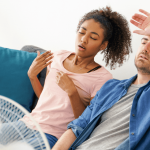
A/C Parts: A Beginner’s Guide
When you turn down the thermostat on a sweltering summer day, cool air seems to magically fill your home. But behind the scenes, your air conditioning system is working hard. Tucked away in walls, outside your house and even up in the attic, a system of A/C parts are quietly running overtime to keep you comfortable.
From the blower motor that pushes air through your vents to the condenser that releases heat outdoors, every part plays a critical role. Understanding how your system works can help you avoid surprise breakdowns, prevent higher energy bills and keep everything running smoothly.
This guide will walk you through the key parts of your A/C unit and help you recognize when it’s time to call a professional.
Indoor vs. Outdoor A/C Parts
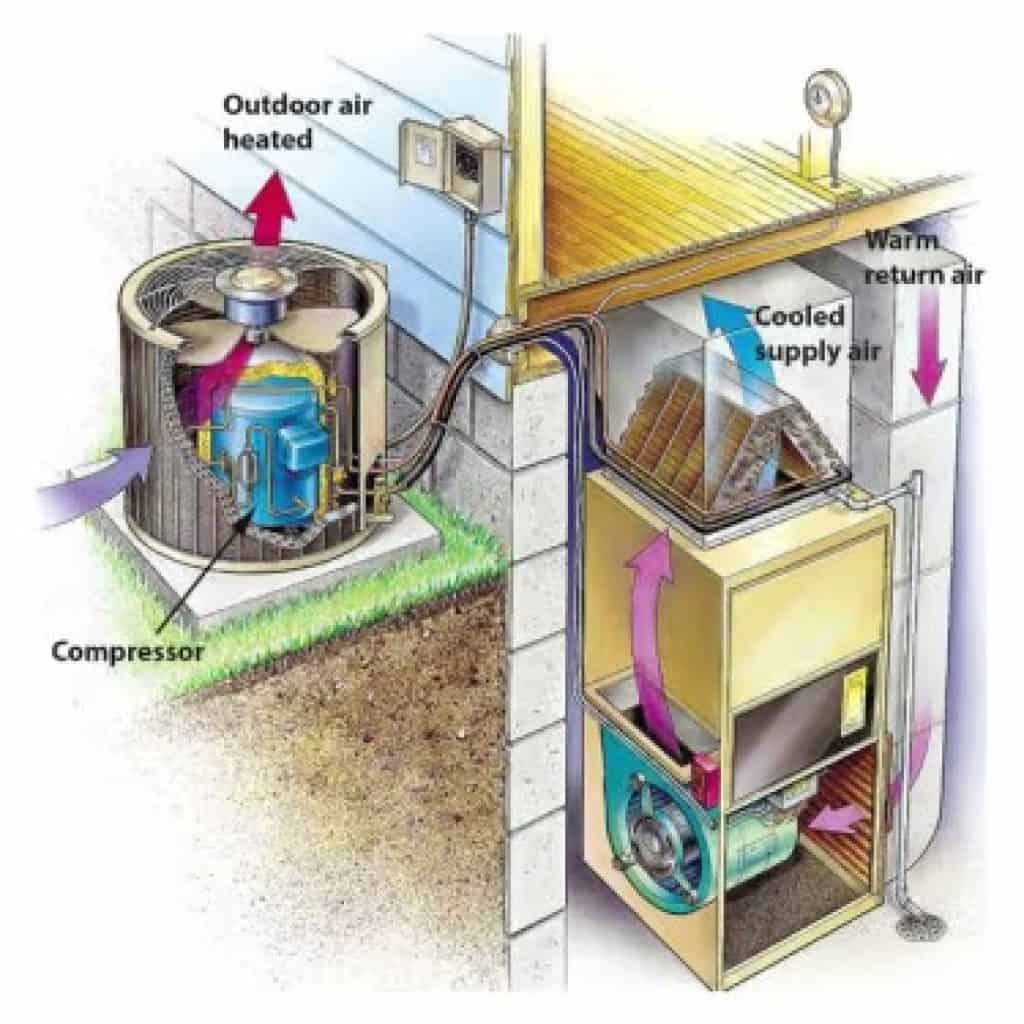
Your A/C system relies on a team of indoor and outdoor components working together to keep your home cool and comfortable.
Indoor parts include the evaporator coil, blower fan, thermostat, air filter and ductwork. All play a part in circulating and regulating cool air throughout your home.
Outdoor parts such as the compressor, condenser coil, condenser fan and refrigerant lines work to release heat and keep the cooling process running efficiently. Together, these parts form a seamless system designed to deliver relief from the heat.
Outdoor A/C Parts
Most of us don’t give much thought to the big, noisy unit outside until something goes wrong. But understanding the key components of your outdoor A/C unit can help you stay ahead of problems, and you don’t even have to break a sweat to get the basics.
Compressor
Often called the “heart” of your A/C system, the compressor is responsible for pressurizing the refrigerant and circulating it through the system. It raises the refrigerant’s temperature and transforms it from a gas to a liquid, allowing the cooling cycle to function properly. Housed inside the outdoor unit alongside the condenser coil, the compressor is essential for effective cooling. Warning signs of compressor trouble include loud or unusual noises, warm air coming from vents, frequent circuit breaker trips or a visibly shaking unit. Because it’s one of the costliest parts to replace, regular maintenance is crucial.
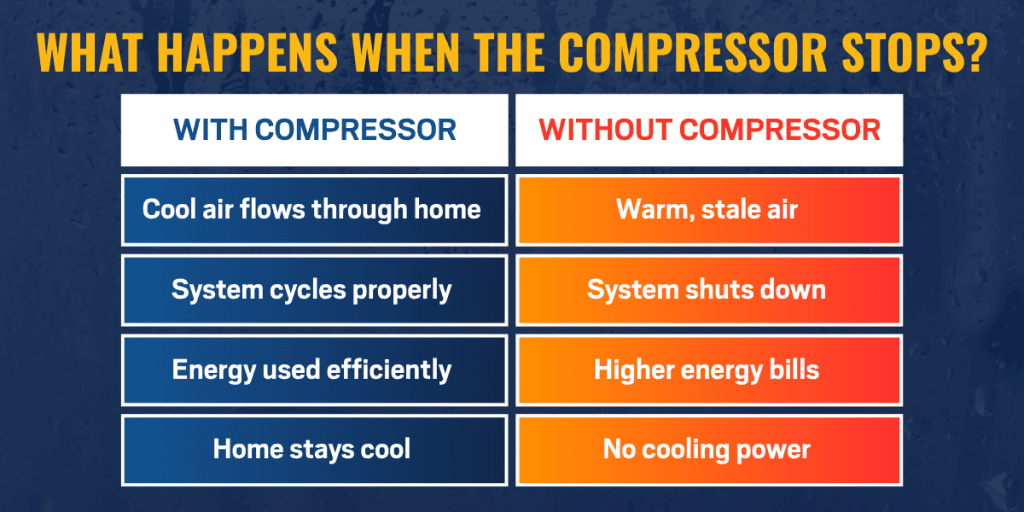
Condenser Coil
The condenser coil acts like a radiator, releasing heat from your home into the outdoor air. As the outdoor fan blows air across the coil, it cools the hot refrigerant and allows it to return to a liquid state. This step is vital for maintaining the cooling cycle. Proper airflow around the coil is key, therefore keep it clear of leaves, dirt and yard debris. If the unit becomes icy or frosty (when it’s not winter), shut it off and contact a technician. A dirty or damaged coil can reduce efficiency and strain your system.
Condenser Fan and Motor
This A/C part pulls air through the condenser coil to help carry heat away from the refrigerant. If it stops working, heat builds up quickly and your A/C can’t cool effectively. Because the fan motor runs hard during summer months, it’s important to check it regularly for signs of wear, overheating or damage.
Electrical Components (Contactors, Capacitors)
These small parts play a big role in powering your unit. Contactors act like switches, turning the system on and off, while capacitors provide the jolt needed to start the motors. If any of these fail, your A/C may struggle to start, run inconsistently or stop working altogether.
Refrigerant Lines
These insulated copper tubes connect the outdoor unit to the indoor evaporator coil, transporting refrigerant throughout the system. The suction line carries cool, low-pressure refrigerant back to the compressor, while the liquid line sends high-pressure refrigerant to the expansion valve. Leaks or damage can reduce efficiency and lead to expensive repairs.
Cabinet (Casing)
The metal shell of your outdoor unit shields internal components from rain, dirt, debris and curious critters. It also helps minimize noise and ensures proper airflow. Keeping the area around the cabinet clear and clean supports efficient operation and extends the life of your system.
Indoor A/C Parts
While the indoor parts of your A/C system work quietly behind the scenes, we often don’t notice them until something goes wrong. Yet these essential components are hard at work absorbing heat, removing moisture and circulating cool air to keep your home comfortable all year long.
Evaporator Coil
Located inside your indoor unit, the A-shaped evaporator coil is where the cooling process begins. As warm indoor air passes over the coil’s network of small tubes and fins, the refrigerant inside absorbs heat and humidity. The cooled, dehumidified air is then pushed back into your home, while the heat is transferred outside. Even a thin layer of dust can reduce efficiency, forcing your system to work harder. If you notice frost on the coil or inside the unit, shut it off and call a technician.
Air Filter
Before air reaches the evaporator coil, it passes through the air filter, which captures dust, pollen and other airborne particles. A clean filter not only protects your system from dirt buildup but also improves indoor air quality. Clogged filters restrict airflow, strain your system and can lead to higher energy bills and reduced performance.
Thermostat
The thermostat acts as the brain of your A/C system, turning it on or off to maintain your preferred temperature. Today’s thermostats often include programmable or smart features for better energy efficiency and convenience. If your thermostat is malfunctioning or is notcalibrated properly, it can cause your system to run inconsistently or inefficiently.
Drain Pan and Drain Line
As the evaporator coil cools the air, it also removes moisture, which condenses into water. This water collects in a drain pan and flows out through a drain line. If the line becomes clogged, it can cause water to back up, leading to leaks and potential water damage inside your home.
Ductwork
Your duct system distributes cooled air throughout your home. To maintain efficiency and even cooling, ducts should be properly sealed and insulated. Leaky or uninsulated ducts can waste energy and compromise comfort by allowing air to escape before it reaches your living spaces.
Blower Motor and Fan (Air Handler or Furnace Fan)
The blower motor drives the fan that circulates cooled (or heated) air through your ductwork and into your home. It’s a critical component for maintaining year-round comfort. Many systems feature variable-speed motors, which adjust airflow for better temperature control, quieter operation and improved energy efficiency. Single-speed motors, while more budget-friendly, can be noisier and less effective at managing humidity. If you hear loud motor noises or notice weak airflow, it’s time to have your system inspected.

Working to Keep You Cool Every Day
Your A/C system is more than just a box that blows cold air. It’s a network of hardworking components that work together to keep your home cool and comfortable, especially during the hottest months. Understanding the basics of how these A/C parts function can help you spot issues early, avoid unexpected breakdowns and keep your system running efficiently.
If you notice strange noises, weak airflow or rising energy bills, don’t ignore the warning signs as these could point to a specific component in need of attention. When even one part isn’t performing properly, it can strain the entire system and lead to bigger, more costly problems. Regular maintenance and prompt repairs can extend your unit’s lifespan and save you money in the long run.
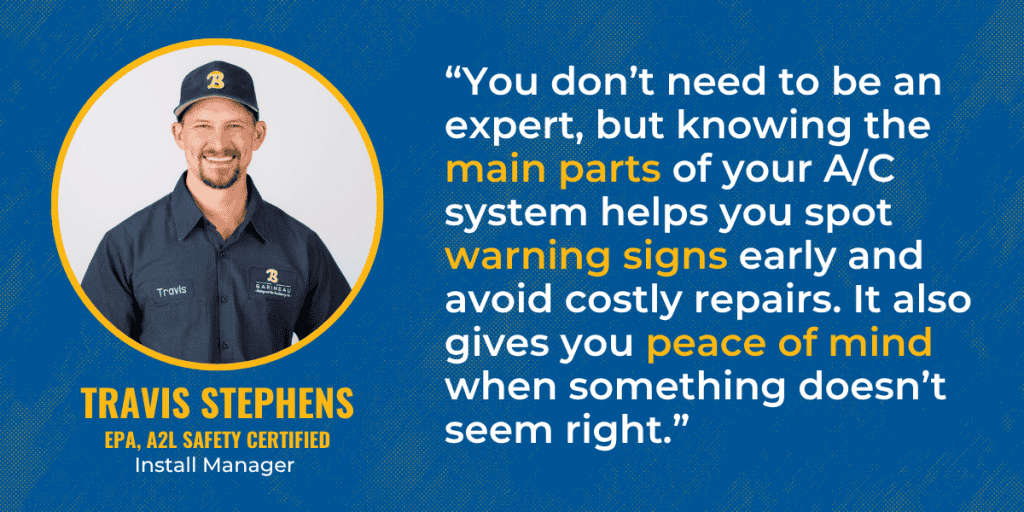
Trust the Experts
The professionals of Barineau Heating and Air Conditioning have been proudly serving north Florida, south Georgia and the Emerald Coast areas for more than 50 years and three generations with top-quality home comfort service. Through committed hard work, integrity, ingenuity and treating customers like family, Barineau has built a reputation as the premier HVAC service company in the area.
With Barineau Heating and Air Conditioning’s Total Comfort Service Program, you’ll receive several cost incentives, such as no overtime charges and a discount on repairs. Signing up for an annual plan removes the burden of having to remember annual maintenance appointments, and you will receive priority service whenever you need us. You can rest easy knowing that Barineau has your back and will remind you when it’s time for your appointment.
Have questions? Call our team at (850) 580-4029 or schedule an appointment.
